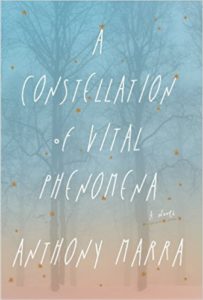
In his young life, the promising American writer Anthony Marra has already won awards, but he deserves another one simply for having the guts to write A Constellation of Vital Phenomena. It’s set in the Caucasus, no less, and during the worst of Russia’s brutal Chehnyan War. It seems exceedingly unlikely that Marra has any experience of war or has ever lived in Chechnya. His credentials (apart from those literary awards) seem limited to an undergraduate degree from the University of Southern California, an MFA from the Iowa Writer’s Workshop, and a fellowship at Stanford, where he’s hanging out now.
Estimated reading time: 3 minutes
Despite these limitations, which would likely strike the average National Book Award-winner as insurmountable, Marra does a convincing job of portraying the interior dialogue of his characters, marooned in the scorched earth of their ancestral homeland. By immersing the reader in the telling details of everyday life in this hellhole of unending terror, he manages to transcend the particulars of his story and conjure up the universal feelings that roil around in us all: love, envy, fear, betrayal, loneliness, hope.
A Constellation of Vital Phenomena by Anthony Marra ★★★★☆
Fascinating characters portrayed in depth
The principal characters of A Constellation of Vital Phenomena are:
- Akhmed, “the worst doctor in Chechnya,” who cut medical school classes to study art
- Sonja Rabina, a brilliant ethnic Russian surgeon who left a prestigious residency in London to return home when war broke out
- An eight-year-old girl named Havaa who became an orphan when “the Feds” burned down her house and dragged away her father (as we learn in the opening lines of the novel), and
- Khassan, an aging history scholar whose faith in Marxism was shattered, and his life’s work rendered pointless, by the revelations following the collapse of the Soviet Union.
These characters, and others, form an accidental community, crowded together by the tragic events around them. “As a web is no more than holes woven together,” writes Marra, “they were bonded by what was no longer there.”
Five days’ events that encompass a country’s history
A Constellation of Vital Phenomena is structured as a tale of five days’ events, but it doesn’t read that way. In fact, during each “day,” we’re rocketed back and forth across a stretch of more than a decade, from the early 90s to 2004, with vivid flashbacks that loom larger than contemporary events–and flashes of the characters’ future that obviate an epilogue. Marra explains: “time didn’t march forward; instead it turned from day to night, from hospital to flat, from cries to silence, from claustrophobia to loneliness and back again, like a coin flipping from side to side.”
The precocious and wise young child, Havaa, is unhappy with the unfairness of it all: “It’s stupid. There are maps to show you how to get to the place where you want to be but no maps that show you how to get to the time when you want to be.” As a reader, you may feel a little bit like Havaa. However, if you manage to navigate through the years and still follow the arc of the story, you’ll find A Constellation of Vital Phenomena highly rewarding by the end.
Oh, and by the way, the title is taken from a Russian medical dictionary. It’s the lead definition for the word life.
For related reading
I’ve also reviewed the author’s second novel, Mercury Pictures Presents (European refugees add luster to wartime Hollywood).
If you enjoy reading history in fictional form, check out 20 most enlightening historical novels. And if you’re looking for exciting historical novels, check out Top 10 historical mysteries and thrillers. You might also be interested in Top 10 great popular novels.
And you can always find my most popular reviews, and the most recent ones, on the Home Page.


























